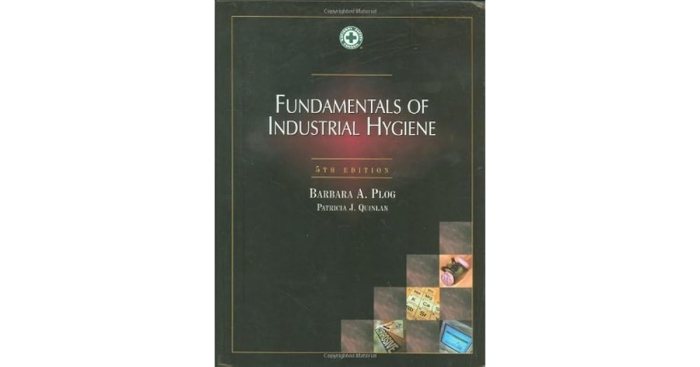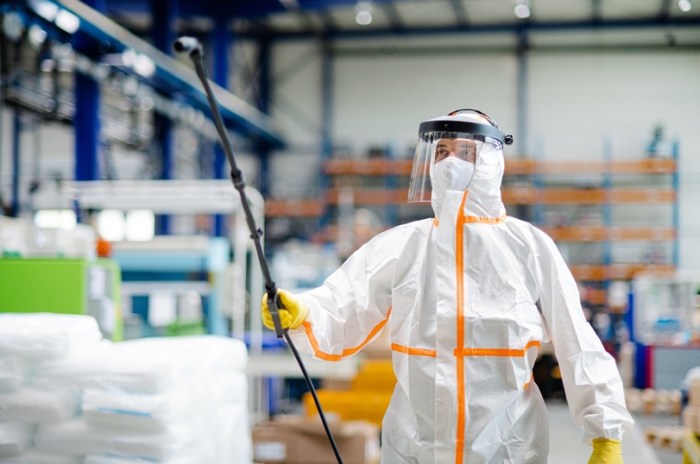Fundamentals of industrial hygiene 7th edition – Fundamentals of Industrial Hygiene, 7th Edition, is the definitive resource for understanding the principles and practices of industrial hygiene, a critical field dedicated to protecting the health and well-being of workers in various industries.
This comprehensive guide delves into the identification, evaluation, and control of occupational hazards, empowering readers with the knowledge and tools to create and maintain safe and healthy work environments.
1. Introduction
Industrial hygiene is the science and art of anticipating, recognizing, evaluating, and controlling workplace hazards that may result in injury, illness, or impairment.
It is a critical part of occupational health and safety, as it helps to ensure that workers are protected from exposure to hazardous substances and conditions.
Types of Industrial Hygiene Hazards, Fundamentals of industrial hygiene 7th edition
- Chemical hazards
- Physical hazards
- Biological hazards
- Ergonomic hazards
- Psychosocial hazards
2. Principles of Industrial Hygiene: Fundamentals Of Industrial Hygiene 7th Edition

Principles of Industrial Hygiene
The principles of industrial hygiene are based on the hierarchy of controls, which is a framework for identifying and implementing the most effective methods for controlling workplace hazards.
- Elimination
- Substitution
- Engineering controls
- Administrative controls
- Personal protective equipment (PPE)
Role of the Industrial Hygienist
Industrial hygienists are professionals who are responsible for assessing, evaluating, and controlling workplace hazards.
They work with employers and employees to develop and implement safety programs that protect workers from exposure to hazardous substances and conditions.
Methods Used to Assess Industrial Hygiene Hazards
- Workplace inspections
- Sampling and analysis
- Medical surveillance
- Hazard identification and risk assessment
3. Control of Industrial Hygiene Hazards
Methods Used to Control Industrial Hygiene Hazards
There are a variety of methods that can be used to control industrial hygiene hazards, including:
- Engineering controls
- Administrative controls
- Personal protective equipment (PPE)
Importance of Personal Protective Equipment (PPE)
PPE is an important part of an industrial hygiene program, as it can help to protect workers from exposure to hazardous substances and conditions.
PPE can include items such as respirators, gloves, eye protection, and hearing protection.
Role of Engineering Controls in Reducing Industrial Hygiene Hazards
Engineering controls are a type of hazard control that is designed to eliminate or reduce the exposure of workers to hazardous substances and conditions.
Engineering controls can include measures such as ventilation, dust collection systems, and machine guards.
4. Health Effects of Industrial Hygiene Hazards

Health Effects of Different Industrial Hygiene Hazards
Exposure to industrial hygiene hazards can have a variety of health effects, including:
- Cancer
- Respiratory disease
- Skin disease
- Eye disease
- Reproductive disorders
Types of Occupational Diseases
Occupational diseases are diseases that are caused by exposure to hazardous substances and conditions in the workplace.
Some common types of occupational diseases include:
- Asbestos-related diseases
- Silicosis
- Coal workers’ pneumoconiosis
- Mesothelioma
- Occupational asthma
Role of Industrial Hygiene in Preventing Occupational Diseases
Industrial hygiene plays an important role in preventing occupational diseases by identifying and controlling workplace hazards.
By working with employers and employees to develop and implement safety programs, industrial hygienists can help to protect workers from exposure to hazardous substances and conditions.
5. Industrial Hygiene Programs

Components of an Industrial Hygiene Program
An industrial hygiene program is a comprehensive plan that is designed to protect workers from exposure to hazardous substances and conditions.
An industrial hygiene program typically includes the following components:
- Hazard identification and risk assessment
- Exposure monitoring
- Control measures
- Medical surveillance
- Training and education
Importance of Training and Education in Industrial Hygiene
Training and education are essential components of an industrial hygiene program.
Workers need to be trained on the hazards that they may be exposed to, the control measures that are in place, and the proper use of PPE.
Role of Industrial Hygiene in Maintaining a Healthy Workplace
Industrial hygiene plays an important role in maintaining a healthy workplace.
By identifying and controlling workplace hazards, industrial hygienists can help to protect workers from exposure to hazardous substances and conditions.
This can help to reduce the risk of occupational diseases and injuries, and can also improve the overall health and well-being of workers.
FAQ
What is the primary focus of industrial hygiene?
Industrial hygiene focuses on identifying, evaluating, and controlling hazards in the workplace to protect the health and well-being of workers.
Why is industrial hygiene important?
Industrial hygiene is crucial for preventing occupational diseases, injuries, and other health-related issues that can arise from exposure to hazardous substances or conditions in the workplace.
What are some common industrial hygiene hazards?
Common industrial hygiene hazards include chemical substances, noise, vibration, radiation, and ergonomic stressors.